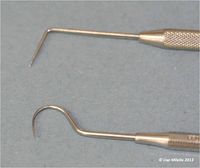Difference between revisions of "Dental Explorer"
Jump to navigation
Jump to search
Fiorecastro (talk | contribs) |
|||
| (One intermediate revision by one other user not shown) | |||
| Line 13: | Line 13: | ||
{{Lisa Milella written | {{Lisa Milella written | ||
|date = 13 August 2014}} | |date = 13 August 2014}} | ||
| − | |||
| − | |||
| − | |||
| − | |||
{{Waltham}} | {{Waltham}} | ||
| − | + | {{OpenPages}} | |
| − | |||
| − | |||
[[Category:Oral Examination Instruments - Small Animal]] | [[Category:Oral Examination Instruments - Small Animal]] | ||
[[Category:Waltham reviewed]] | [[Category:Waltham reviewed]] | ||
Revision as of 13:48, 2 November 2014
The dental explorer or probe, is a sharp-ended instrument.
It is used to check for hard tissue defects, for example:
- To determine the presence of caries
- To explore other enamel and dentin defects, such as fractured teeth and odontoclastic resorptive lesions
The explorer is also useful for tactile examination of the subgingival tooth surfaces. Subgingival calculus and odontoclastic resorptive lesions may be identified in this way. Dental explorers are available in various shapes, usually straight or curved. The Shepherds hook pattern is frequently used in veterinary dentistry, but a probe with a 90 degree bend is often easier to use, and more useful.
| This article was written by Lisa Milella BVSc DipEVDC MRCVS. Date reviewed: 13 August 2014 |
| Endorsed by WALTHAM®, a leading authority in companion animal nutrition and wellbeing for over 50 years and the science institute for Mars Petcare. |
Error in widget FBRecommend: unable to write file /var/www/wikivet.net/extensions/Widgets/compiled_templates/wrt694bc472821999_21404014 Error in widget google+: unable to write file /var/www/wikivet.net/extensions/Widgets/compiled_templates/wrt694bc472868f74_96928948 Error in widget TwitterTweet: unable to write file /var/www/wikivet.net/extensions/Widgets/compiled_templates/wrt694bc4728aaaf3_51035959
|
| WikiVet® Introduction - Help WikiVet - Report a Problem |
